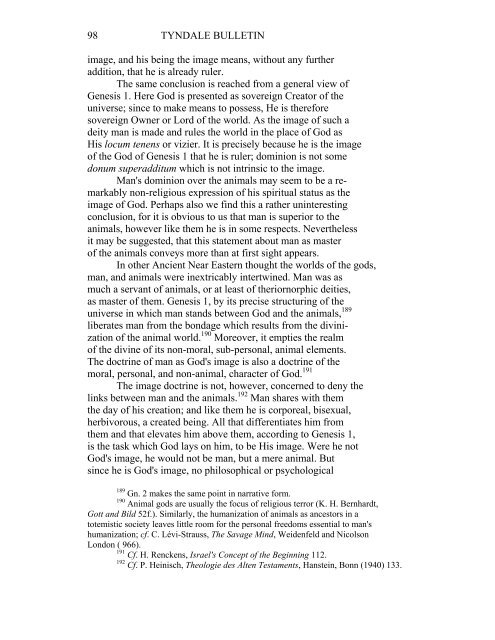THE IMAGE OF GOD IN MAN - Tyndale House
THE IMAGE OF GOD IN MAN - Tyndale House
THE IMAGE OF GOD IN MAN - Tyndale House
- TAGS
- tyndale
- tyndalehouse.com
You also want an ePaper? Increase the reach of your titles
YUMPU automatically turns print PDFs into web optimized ePapers that Google loves.
98 TYNDALE BULLET<strong>IN</strong><br />
image, and his being the image means, without any further<br />
addition, that he is already ruler.<br />
The same conclusion is reached from a general view of<br />
Genesis 1. Here God is presented as sovereign Creator of the<br />
universe; since to make means to possess, He is therefore<br />
sovereign Owner or Lord of the world. As the image of such a<br />
deity man is made and rules the world in the place of God as<br />
His locum tenens or vizier. It is precisely because he is the image<br />
of the God of Genesis 1 that he is ruler; dominion is not some<br />
donum superadditum which is not intrinsic to the image.<br />
Man's dominion over the animals may seem to be a re-<br />
markably non-religious expression of his spiritual status as the<br />
image of God. Perhaps also we find this a rather uninteresting<br />
conclusion, for it is obvious to us that man is superior to the<br />
animals, however like them he is in some respects. Nevertheless<br />
it may be suggested, that this statement about man as master<br />
of the animals conveys more than at first sight appears.<br />
In other Ancient Near Eastern thought the worlds of the gods,<br />
man, and animals were inextricably intertwined. Man was as<br />
much a servant of animals, or at least of theriornorphic deities,<br />
as master of them. Genesis 1, by its precise structuring of the<br />
universe in which man stands between God and the animals, 189<br />
liberates man from the bondage which results from the divini-<br />
zation of the animal world. 190 Moreover, it empties the realm<br />
of the divine of its non-moral, sub-personal, animal elements.<br />
The doctrine of man as God's image is also a doctrine of the<br />
moral, personal, and non-animal, character of God. 191<br />
The image doctrine is not, however, concerned to deny the<br />
links between man and the animals. 192 Man shares with them<br />
the day of his creation; and like them he is corporeal, bisexual,<br />
herbivorous, a created being. All that differentiates him from<br />
them and that elevates him above them, according to Genesis 1,<br />
is the task which God lays on him, to be His image. Were he not<br />
God's image, he would not be man, but a mere animal. But<br />
since he is God's image, no philosophical or psychological<br />
189 Gn. 2 makes the same point in narrative form.<br />
190 Animal gods are usually the focus of religious terror (K. H. Bernhardt,<br />
Gott and Bild 52f.). Similarly, the humanization of animals as ancestors in a<br />
totemistic society leaves little room for the personal freedoms essential to man's<br />
humanization; cf. C. Lévi-Strauss, The Savage Mind, Weidenfeld and Nicolson<br />
London ( 966).<br />
191 Cf. H. Renckens, Israel's Concept of the Beginning 112.<br />
192 Cf. P. Heinisch, Theologie des Alten Testaments, Hanstein, Bonn (1940) 133.

















